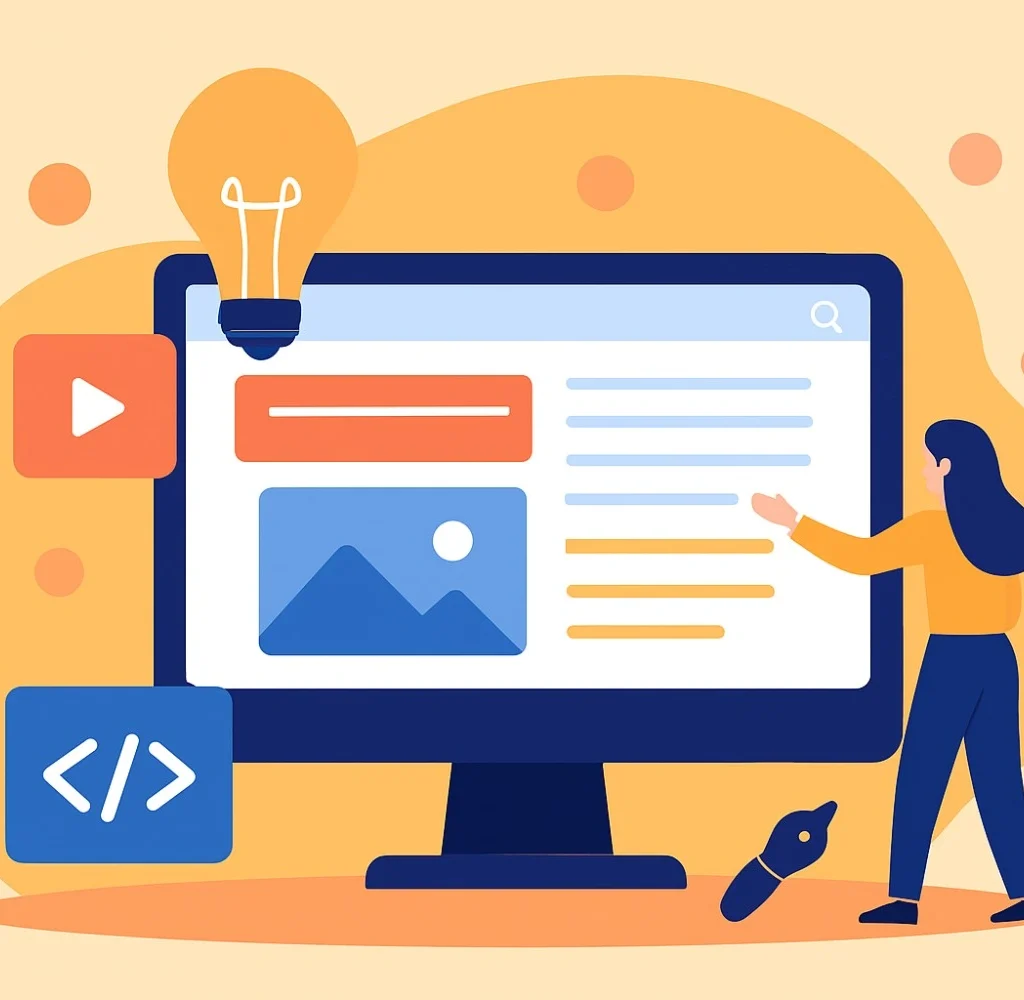In the ever-changing world of technology, one thing remains constant the importance of Web Designing. From small businesses to global brands, every organization relies on websites as their digital home. The design of these websites plays a huge role in how users see, feel, and interact with a brand. As we step into 2025 and beyond, the future of Web Designing is evolving faster than ever.
For businesses, especially those working with innovators like the Top IT Companies in Dubai, staying ahead of these design trends isn’t just optional it’s essential. A well-designed website no longer just looks good; it communicates trust, creates engagement, and drives results.
So, what does the future hold for Web Designing? Let’s explore the major trends that will shape the digital world in 2025 and beyond.
Table of Contents
- Simplicity Over Complexity
- Personalized User Experiences
- AI and Automation in Design
- Voice-Friendly Design
- Mobile-First Approach
- Dark Mode and Visual Comfort
- Motion and Micro-Interactions
- Sustainable Web Designing
- Accessibility for All
- Augmented and Virtual Reality
- Human-Centered Storytelling
- Faster Load Speeds
- Hyper-Personalized E-Commerce
- The Future Is Fluid
- Final Thoughts

Simplicity Over Complexity
The future of Web Designing leans heavily on simplicity. In an age where people scroll faster than ever, complicated designs only confuse users. Clean layouts, minimal color schemes, and clear navigation are now the key to keeping visitors engaged.
Designers are moving away from cluttered pages and instead focusing on what matters most: helping users find the information they need quickly. A simple design doesn’t mean boring. It means effective, user-friendly, and stress-free.
Personalized User Experiences
One of the biggest shifts in Web Designing is personalization. In 2025, websites will adapt themselves to each user’s preferences, behavior, and interests. Imagine landing on a website and instantly seeing products, services, or content that feels made just for you.
AI-powered personalization is becoming mainstream, and designers are building experiences that make users feel valued. The goal is clear: turn casual visitors into loyal fans by showing them what they want before they even search for it.
AI and Automation in Design
Artificial Intelligence is no longer a buzzword. It’s becoming a real tool in the hands of designers. In Web Designing, AI is helping to create smarter layouts, optimize user journeys, and even write parts of the website automatically.
By 2025, we will see more websites designed or co-designed by AI. These platforms will analyze user data in real-time, adjust layouts, and deliver seamless experiences without human effort. This doesn’t replace designers but empowers them to focus on creativity while AI handles repetitive tasks.
Voice-Friendly Design
As voice search grows through devices like Alexa, Google Assistant, and Siri, Web Designing is adapting to this trend. Users are now asking questions instead of typing, and websites must be prepared to provide answers in natural language.
This means websites will focus more on conversational design, FAQs, and structures that allow voice assistants to fetch information easily. In 2025, websites without voice-friendly design may risk falling behind.
Mobile-First Approach
Mobile traffic has already surpassed desktop, and the future of Web Designing makes mobile the first priority. Designers now think about how a site looks on a smartphone before even considering the desktop version.
In 2025, we’ll see more mobile-first animations, gestures, and layouts that make browsing smooth on smaller screens. From thumb-friendly buttons to quick-loading visuals, mobile-first design ensures no user feels left out.
Dark Mode and Visual Comfort
Dark mode is no longer a trend; it’s becoming a standard. Users love the option to switch between light and dark themes, and Web Designing is evolving to provide that flexibility.
In the future, more websites will come with adaptive designs that change based on time of day, device settings, or user preference. Beyond aesthetics, this also reduces eye strain and improves readability, making websites more comfortable to use.
Motion and Micro-Interactions
Movement attracts attention. That’s why the future of Web Designing includes animations, transitions, and micro-interactions that guide users naturally.
For example, when you hover over a button and it gently changes color or shakes, that’s a micro-interaction. These small details may seem minor, but they play a huge role in making a website feel alive, modern, and engaging.
By 2025, expect websites to become more dynamic with 3D animations, scroll-triggered effects, and interactive elements — all designed to make browsing fun and memorable.
Sustainable Web Designing
With rising concerns about the environment, sustainability is entering the world of design. Websites in the future will focus on energy-efficient designs, lighter code, and eco-friendly hosting.
Why? Because faster, cleaner websites consume less energy. For brands, embracing sustainable Web Designing not only helps the planet but also builds trust with eco-conscious users.
Accessibility for All
The future of Web Designing is inclusive. Websites will be built for everyone, including people with disabilities. Designers are now ensuring that colors have enough contrast, fonts are readable, and navigation is accessible by keyboard or screen readers.
This isn’t just about compliance; it’s about empathy. In 2025, the most successful websites will be the ones that make every visitor feel welcome.
Augmented and Virtual Reality
Another big game-changer in Web Designing is the integration of AR (Augmented Reality) and VR (Virtual Reality). Imagine shopping online and being able to “try on” clothes virtually or preview furniture in your living room before buying.
These immersive experiences are no longer futuristic dreams; they are becoming a reality. By 2025, more websites will blend AR and VR features, making online shopping, education, and entertainment more engaging than ever.
Human-Centered Storytelling
In the future, Web Designing will be less about pages and more about stories. Users don’t just want information; they want experiences that connect with them emotionally.
Story-driven websites use visuals, text, and motion to guide visitors through a journey. This builds deeper trust and creates stronger memories. After all, people may forget numbers, but they never forget a good story.
Faster Load Speeds
Patience online is at an all-time low. If a website takes longer than a few seconds to load, users leave. That’s why the future of Web Designing is built on speed.
Lightweight graphics, optimized code, and next-generation hosting will all ensure websites load almost instantly. Fast-loading sites don’t just improve user experience; they also rank better on search engines.

Hyper-Personalized E-Commerce
Shopping online is about to get a lot more exciting. Future Web Designing in e-commerce will use AI and predictive analytics to recommend products in real-time.
Imagine visiting a store and finding your favorite colors, preferred styles, and even tailored discounts ready for you. This level of personalization will make online shopping feel more like visiting a personal boutique.
The Future Is Fluid
By 2025 and beyond, one truth will stand out: the future of Web Designing is fluid. Technology will keep changing, and user expectations will keep growing. The key to success lies in flexibility.
Designers and businesses must be ready to adapt quickly, embrace new tools, and always put users first. A beautiful design today may feel outdated tomorrow, but a website built on adaptability will always stay relevant.
Final Thoughts
The world of Web Designing is on the edge of incredible transformation. From AI-powered personalization and immersive AR experiences to sustainable practices and inclusive designs, the future is bright, fast, and user-focused.
Websites will no longer just be digital addresses. They will become living, breathing experiences that connect, inspire, and drive results.
For businesses, this means one simple truth: keeping up with the future of Web Designing is not an option it’s the key to survival and growth.
As we look ahead to 2025 and beyond, one thing is clear: the best websites won’t just be designed; they’ll be experienced.



Add a Comment